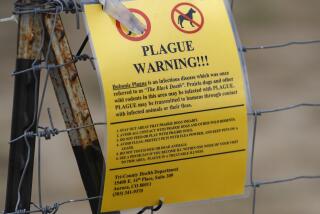A doctor, a priest and a prisoner
- Share via
For centuries, the gruesome disease once known as leprosy separated husbands from wives and parents from children. The sick -- missing digits and limbs, their faces swollen and disfigured, their oozing sores emitting a putrid smell -- were exiled to isolated colonies and often left to die. But in a single year toward the end of the 19th century, the acts of a Norwegian doctor and a Belgian priest slowly began to redirect the fates of leprosy patients around the world.
---
Some of the most notable changes in the plight of the leprous originated in colonial Hawaii. The patients there had been banished to the island of Molokai, chosen for its steep cliffs. Living in shacks and caves with little food and undrinkable water, no medical care and no contact with the outside world, Hawaii’s “lepers” were no different from others all over the globe.
Traveling to Molokai in 1873, Father Damien, a Catholic priest from Belgium, embraced the patients, figuratively and literally. He decided to stay. When he preached, the healthy priest referred to himself and his congregation as “we lepers” in solidarity.
Damien built a pipeline to carry water to the island’s settlement and urged authorities to provide clothing, food and wood for building homes. When the supplies arrived, he rolled up his sleeves and started hammering.
Damien also pressed for doctors, but few agreed to come. Those who did refused to touch the patients, nudging medications toward them with a stick.
Meanwhile, in America and Europe, debate raged about what leprosy actually was: contagious or hereditary? A form of syphilis or a separate disease? The same year Damien arrived in Molokai, a young Norwegian doctor, Gerhard Hansen, began to study the disease to find out.
He looked closely at nodules in patients’ lymph nodes and found they weren’t filled with dead cells, as previously thought, but with what appeared to be living organisms, shaped like little rods. Hanson suspected a germ, and set out to prove his case.
He tried to stain the rods to view them under a microscope, but failed. He attempted to take the germs from sick patients and cause the disease in healthy ones -- but this effort was unsuccessful too. Finally, in his attempt to prove contagion, he plunged a syringe full of the rod-shaped germs into the eye of a female patient. The woman’s eye was fine, but Hansen was taken to court, fined and stripped of one of his two professional posts.
But word of Hansen’s potential leprosy germ had spread, and doctors elsewhere attempted to mimic the experiment and prove the link.
In Hawaii, where Damien was still working in 1884, a death row inmate named Keanu offered himself up as a guinea pig in exchange for having his sentence commuted to life in prison. Doctors sewed a nodule from a leprosy patient into Keanu’s arm -- and two years later, he developed the disease.
Keanu was exiled to Molokai, where he lived with the disease for eight years in the company of Damien. By then, Damien was leprous too, and little doubt over leprosy’s contagion remained.
Damien traveled to Honolulu briefly for treatment, but ultimately chose to return to Molokai. He died there in 1889, an old, disfigured man at the age of 50.
His illness and death brought worldwide attention to the plight of leprosy patients, which gradually began to improve. By the 1940s, antibiotics were deployed against the disease, and patients in many countries were permitted to go home.
Yet many chose, as Damien did, to stay where they were. In fact, several dozen patients with leprosy, which is now known as Hansen’s disease, live on Molokai to this day, no longer, of course, against their will.
-- Elena Conis





